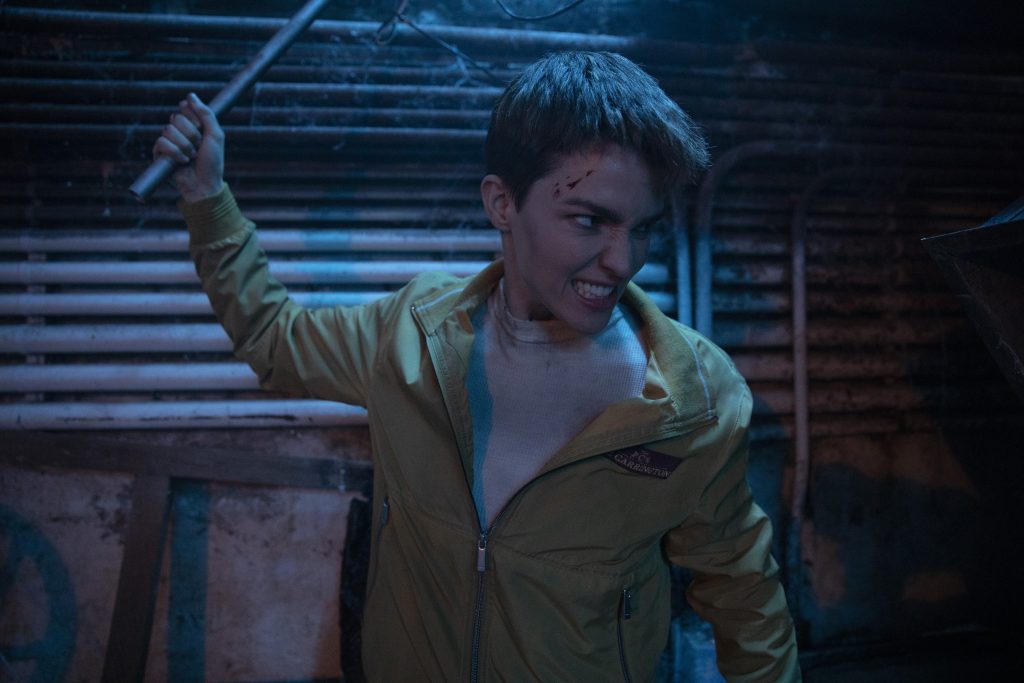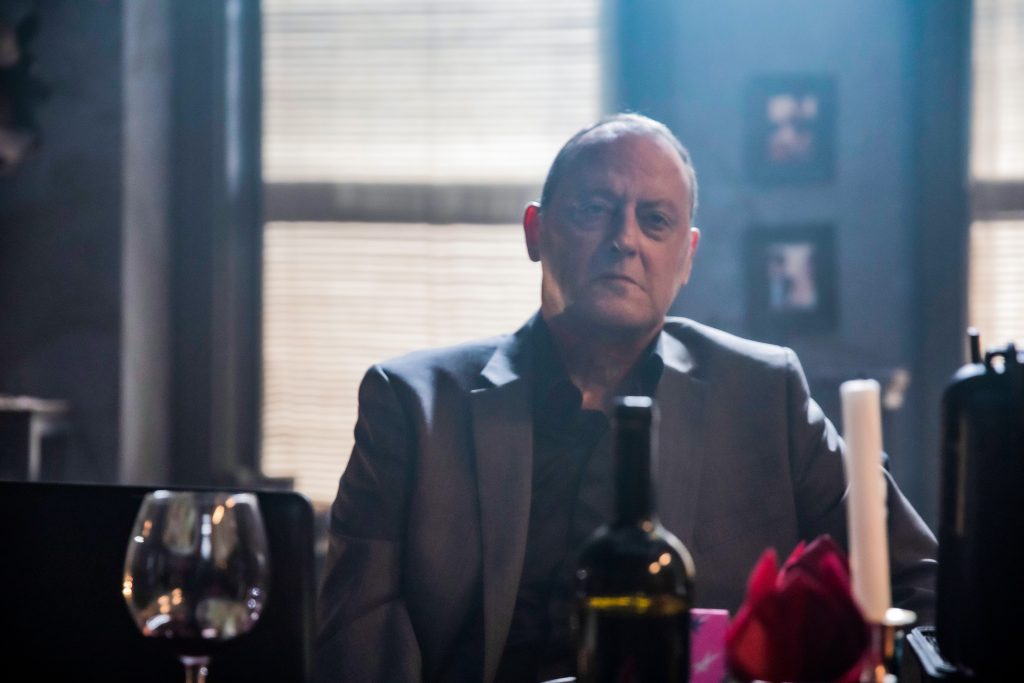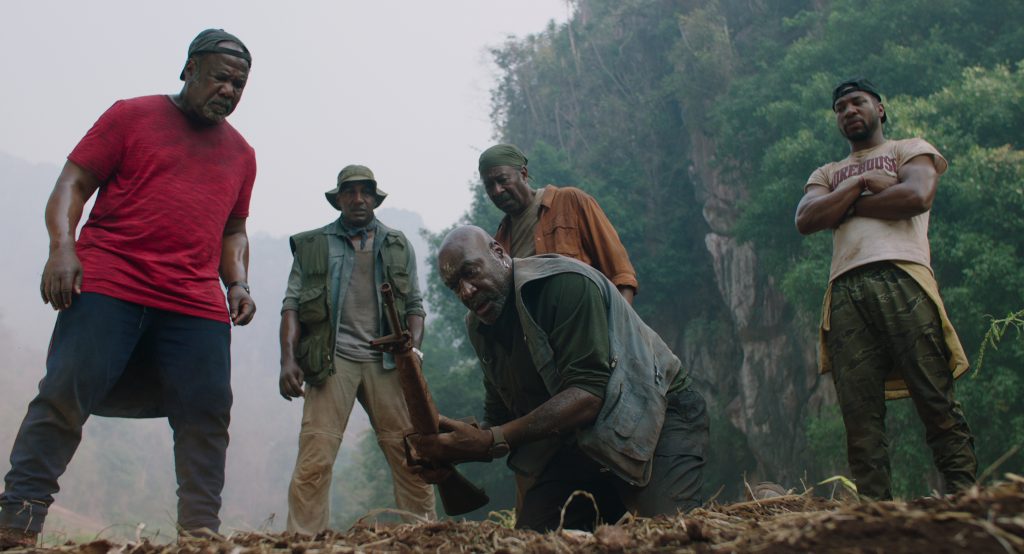October 15, 2020
by Carla Hay

Directed by Ryuhei Kitamura
Culture Representation: Taking place primarily in New York City, the action flick “The Doorman” features a predominantly white cast of characters (with a few Asians) representing the middle-class and criminal underground.
Culture Clash: A former Marine takes a job as a doorman at an upscale apartment building and finds herself battling with art thieves who take her and some of her family members hostage.
Culture Audience: “The Doorman” will appeal primarily to people who don’t mind watching formulaic and forgettable action movies.

“The Doorman” is one of those “taken hostage and trapped in a building” movies that’s nothing more than a predictable and uncreative variation of the classic 1988 Bruce Willis film “Die Hard.” Directed by Ryuhei Kitamura, “The Doorman” makes almost no attempt to do anything new with the formula that’s been endlessly copied since “Die Hard” became an influential blockbuster. The only fairly unusual aspect of the film is that the action hero in this movie is a woman. And the movie is a reminder that being a front-lobby attendant is such a male-dominated job that it’s still referred to as being a doorman.
Three people are credited with writing “The Doorman” screenplay: Lior Chefetz, Joe Swanson and Devon Rose. And apparently none of them could think of a plausible reason for why a cell phone couldn’t be used to get help in this emergency situation when the hero of the story temporarily breaks free from the hostages but is still in the apartment building where the home invasion takes place. Viewers are expected to accept the flimsy explanation that cell-phone service isn’t working in that particular building because the building is undergoing renovations.
Before the hostage situation happens, the movie gives a brief introduction to the protagonist of “The Doorman” and the life she had before she began working in the upscale New York City apartment building that’s taken hostage. Her name is Ali Gorsky (played by Ruby Rose), a serious-minded and stoic type who was a sergeant in the Marines. She was part of an elite U.S. military team stationed in an unnamed country. One of her duties was being a bodyguard for an unnamed female U.S. ambassador (played by Andreea Vasile) and the ambassador’s daughter Nira (played by Andreea Androne), who’s about 7 or 8 years old.
While traveling to a speaking engagement, the ambassador is in a convoy of cars in front of and behind her car as protection as they drive through a secluded wooded area. Ali and Nira are along for the ride too. Suddenly, numerous gunmen emerge from the woods and ambush the fleet of cars. The assassins have war weapons, including a rocket launcher, while the military defenders, who just have regular guns, are quickly killed off, one by one.
All of the assassins’ victims die except for Ali, who tries in vain to save the ambassador and her daughter, who become easy targets in the back seat of a car when a rocket launcher is aimed right at them. The explosion propels Ali into the woods in some very cheesy and not-very-believable visual effects, which morph into Ali in New York City waking up from a nightmare where she remembered what happened on that terrible day.
Needless to say, by the time Ali is seen in New York City, she has already left the military in disgrace and she needs another job. She meets with her uncle Pat (played by Philip Whitchurch) at a local bar, where she’s reluctant to talk about her traumatic experience. Pat works as a contractor for building repairs and renovations, and he tells Ali about a job opening for a doorman in the high-rise apartment building where he’s doing renovations. She reluctantly agrees to interview for the job.
The building is called The Carrington, and it’s in an upscale area on Manhattan’s Upper West Side. It’s the type of building that was built before World War II and used to be a hotel. Most of the residents have temporarily moved out because of the renovations. However, some of the residents who are still living there have reasons for why they’ve been allowed to stay in the building.
This poorly written movie doesn’t really show Ali interviewing for the job, which she gets shortly before Easter. She just shows up and meets someone named Borz Blasevic (played by Aksel Hennie), who presents himself as the chief doorman/superintendent, and he immediately tells her to get dressed in the work uniform in the unisex locker room. Borz knows that Ali was referred to by Pat, but Pat tells Ali that he doesn’t want Borz to know that Ali is related to Pat.
And it just so happens that Ali has other relatives in the building, and they are among the few residents who are still living there during the renovations: Her brother-in-law Jon Stanton (played by Rupert Evans), a professor who’s originally from England; Jon’s son Max (played by Julian Feder), who’s about 15 or 16 years old; and Jon’s daughter Lily (played by Kila Lord Cassidy), who’s about 11 or 12 years old.
Jon is a widower who used to be married to Ali’s late sister, whose cause of death is not mentioned in the movie. It’s also not mentioned how long Ali’s sister has been dead, but it’s implied that it’s been less than two years. Jon is a written as a generic father with not much of a personality. Max, who is often sullen, has antisocial tendencies because he apparently spends a lot of time alone smoking marijuana and playing video games. Lily is a typical “adorable and precocious” kid that movies like this tend to have whenever children are taken hostage.
Jon and his children have been allowed to remain in the building because they aren’t going to stay for much longer: After Easter vacation, they plan to move back to England, where Jon works. After her sister’s death, Ali has been avoiding being around Jon and the kids because of a secret that is very easy to predict from the moment that Jon and Ali first see each other when he finds out that she’s now working in the building.
On her first day on the job, Ali meets two of the other remaining residents in the building: an elderly couple named Bernard Hersh (played by Petre Moraru) and his wife (played by (Delianne Forget), who doesn’t have a first name in the movie. Bernard had a stroke seven years before, he almost never talks, and he’s wheelchair-bound. His wife, who is his caretaker, explains to Ali that building management allowed them to continue living at The Carrington during renovations because moving to another building would upset Bernard too much.
It isn’t long before danger comes to The Carrington, when a French thief named Victor Dubois (played by Jean Reno) and his small gang of henchmen arrive for a home invasion in the Hershes’ apartment. Of course, these thugs had some help from a building insider, and it’s very easy to figure out who that person is in this relatively small cast of characters. This “inside job” criminal barricades the front door from the inside with chains and a padlock, so the hostages can’t escape. (The movie never shows if any back doors or side doors are also barricaded.)
Victor is there to steal some valuable art paintings that are in the building, and Bernard knows where they are. But things go awry because Victor doesn’t know until he gets there that Bernard is nearly mute and can’t really tell the information that Victor wants. This leads to a torture scene and Victor finding out that the Hershes used to live in the apartment where the Stantons currently live.
And guess who’s taken hostage next while they’re having Easter dinner? Ali is off-duty at the Stantons’ apartment, having what she thought would be just an awkward family reunion dinner at Easter. And because she’s off-duty, she happens to be wearing high heels, which are supposed to make her look like a “feminine badass” when she has the inevitable fights with the home invaders.
The rest of “The Doorman” is about Ali trying to save her relatives through a series of often-preposterous scenarios. The Carrington happens to be a building with hidden rooms and hidden dumbwaiter shafts. And there’s an underground tunnel that was supposed to be a subway tunnel but construction on the tunnel was halted decades ago, and the tunnel was sealed up behind a wall.
As the main character in this stereotypical action flick, Rose doesn’t have much to do except act tough and go through the choreographed motions for the fight sequences. Ali shows some glimmers of being humanly vulnerable in moments with Jon and the children. But for the most part, Ali has a very wooden personality, and Rose doesn’t have much acting range to bring more charisma to this formulaic character.
French actor Reno has been playing villains in B-movies for quite some time, so there’s nothing new or exciting that he does in “The Doorman.” He usually portrays the “brains” of a criminal operation who gets other people to do most of the dirty work. In “The Doorman,” the Victor character is no different, except this mastermind criminal makes a lot of stupid and arrogant decisions that just drag the movie out longer, in order to create a false sense of suspense.
“The Doorman” is the type of bad movie that isn’t so bad that it’s laughable. It’s the type of bad movie that will induce boredom because it’s so tiresome in how unimaginative it is. The fight scenes are unremarkable, and the acting is mediocre at best. The characters you expect to get killed are the ones who get killed. The characters you expect to survive are the ones who survive. There are video games that are better than this cliché-ridden, soulless movie.
Lionsgate released “The Doorman” on digital and VOD on October 9, 2020, and on Blu-ray and DVD on October 13, 2020.


